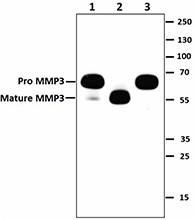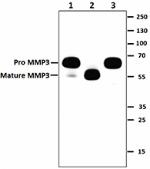- Clone
- M4405F10 (See other available formats)
- Regulatory Status
- RUO
- Other Names
- Progelatinase, STR1, Transin, Stromelysin I, MMP-3, Transin-1, STMY1, SL-1, CHDS6
- Isotype
- Mouse IgG1, κ
- Ave. Rating
- Submit a Review
- Product Citations
- publications

-

Recombinant human MMP3 (50 ng) treated with (lane 2) and without (lane 1) 1 mM of p-aminophenylmercuric acetate (APMA) and recombinant mouse MMP3 (50 ng, lane 3) were resolved by electrophoresis, transferred to nitrocellulose, and probed with purified monoclonal anti-MMP3 (clone M4405F10) antibody. Proteins were visualized using a goat anti-mouse-IgG secondary antibody conjugated to HRP and chemiluminescence detection.
MMP3 is a member of the matrix metalloproteinase family proteins (MMPs). Members of this family are structurally related to zinc-containing enzymes that degrade the extracellular matrix (ECM), connective tissue proteins in normal physiological processes such as embryonic development, reproduction, and tissue remodeling, and in disease processes such as arthritis and metastasis as well. MMP3 consists of a prodomain that is cleaved upon activation, a catalytic domain containing the zinc binding site, a short hinge region, and a carboxyl terminal (hemopexin-like repeats) domain. Substrates of MMP3 include collagen α chains, aggrecan, laminin, fibronectin, elastin, casein, α1-antitrypsin, myelin basic protein, IL1β, IGFBP3, pro MMP1, pro MMP7, pro MMP8, pro MMP9, and pro MMP13. MMP3 is thought to be involved in wound repair, progression of atherosclerosis, and tumor initiation. Also, it has been known that a polymorphism in the MMP3 promoter region is associated with the risk of coronary heart disease and myocardial infarction due to lower MMP3 proteolytic activity and higher ECM deposition in atherosclerotic lesions.
Product DetailsProduct Details
- Verified Reactivity
- Human, Mouse
- Antibody Type
- Monoclonal
- Host Species
- Mouse
- Immunogen
- Recombinant human MMP-3, amino acids Tyr18 -Cys477, was expressed with N-terminal His9-SGGGSGGGIEGR tag in 293E cells.
- Formulation
- Phosphate-buffered solution, pH 7.2, containing 0.09% sodium azide.
- Preparation
- The antibody was purified by affinity chromatography.
- Concentration
- 0.5 mg/ml
- Storage & Handling
- The antibody solution should be stored undiluted between 2°C and 8°C.
- Application
-
WB - Quality tested
- Recommended Usage
-
Each lot of this antibody is quality control tested by Western blotting. For Western blotting, the suggested use of this reagent is 0.5 - 2.5 µg per ml. It is recommended that the reagent be titrated for optimal performance for each application.
- Product Citations
-
- RRID
-
AB_2566077 (BioLegend Cat. No. 679202)
Antigen Details
- Structure
- Belongs to the peptidase M10A family. Monomer. Contains 4 hemopexin-like domains with an approximate predicted molecular weight of 54 kD. Mature form of MMP3 upon activation by p-aminophenylmercuric acetate (APMA), has predicted molecular weight of 45 kD.
- Distribution
- Extracellular. MMP3 is expressed by fibroblasts, chondrocytes, osteoblasts, endothelial cells, smooth muscle cells, and macrophages.
- Function
- MMP3 degrades fibronectin, laminin, gelatins of type I, III, IV, and V, collagens III, IV, X, and IX, and cartilage proteoglycans. It activates procollagenases. MMP3 is thought to play a prominent role in the pathogenesis of rheumatoid arthritis.
- Interaction
- Fibronectin, laminin, collagens III, IV, IX, and X, cartilage proteoglycans, decorin, osteopontin, and IBP-3.
- Ligand/Receptor
- Tissue inhibitors of metalloproteinases (TIMPs).
- Biology Area
- Angiogenesis, Cell Adhesion, Cell Biology, Neuroinflammation, Neuroscience
- Molecular Family
- Enzymes and Regulators
- Antigen References
-
1. Matrisian LM. 1990. Trends Genet. 4:121.
2. Nagase H and Woessner JF Jr. 1999. J. Biol. Chem. 274:21491.
3. Humphries SE, et al. 1998. Atherosclerosis 139:49.
4. Kader AK, et al. 2007. Clin. Cancer Res. 13:2614.
5. Gill SE and Parks WC. 2008. Int. J. Biochem. Cell Biol. 40:1334.
6. Mazor R, et al. 2013. J. Biol. Chem. 288:598.
7. Herath TD, et al. 2013. BMC Microbiol. 13:73. - Gene ID
- 4314 View all products for this Gene ID
- UniProt
- View information about MMP-3 on UniProt.org
Related Pages & Pathways
Pages
Related FAQs
Other Formats
View All MMP-3 Reagents Request Custom Conjugation| Description | Clone | Applications |
|---|---|---|
| Purified anti-MMP3 | M4405F10 | WB |
Compare Data Across All Formats
This data display is provided for general comparisons between formats.
Your actual data may vary due to variations in samples, target cells, instruments and their settings, staining conditions, and other factors.
If you need assistance with selecting the best format contact our expert technical support team.
-
Purified anti-MMP3

Recombinant human MMP3 (50 ng) treated with (lane 2) and wit...








Follow Us